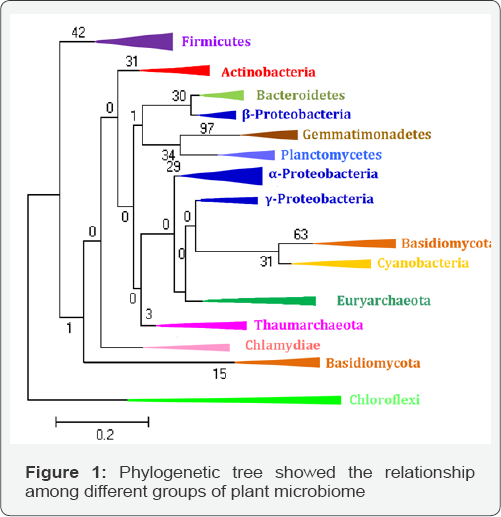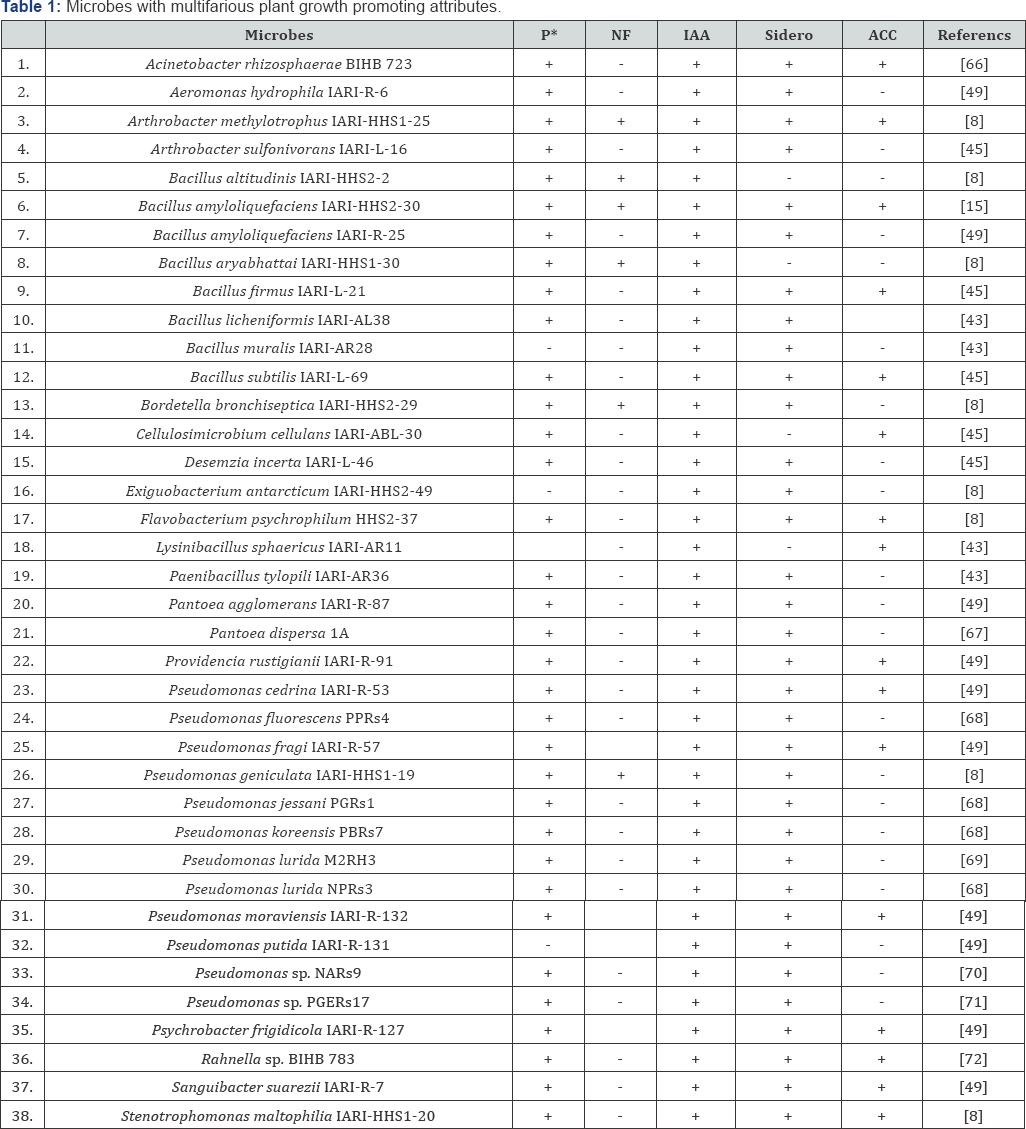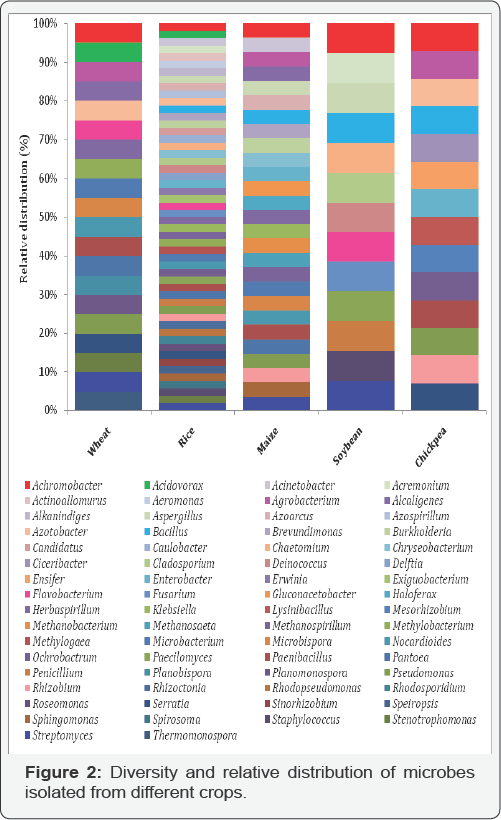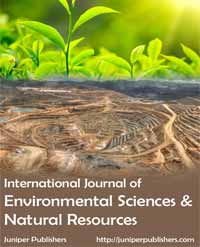Plant Microbiomes and Its Beneficial Multifunctional Plant Growth Promoting Attributes-Juniper Publishers
Juniper Publishers- Open Access Journal of
Environmental Sciences & Natural Resources
Plant Microbiomes and Its Beneficial Multifunctional Plant Growth Promoting Attributes
Authored by Ajar Nath Yadav
Abstract
Plant microbiome (Epiphytic, endophytic and
rhizospheric) plays important role in plant growth, development, and
soil health. Plant and rhizospheric soil are valuable natural resource
harbouring hotspots of microbes, and it plays critical roles in the
maintenance of global nutrient balance and ecosystem function. The
diverse group of microbes is key components of soil-plant systems, where
they are engaged in an intense network of interactions in the
rhizosphere/phyllospheric/endophytic. The microbes with plant growth
promoting (PGP) attributes have emerged as an important and promising
tool for sustainable agriculture. PGP microbes promote plant growth and
development directly or indirectly, either by releasing plant growth
regulators/phytohormones; solubilization of phosphorus, potassium and
zinc; biological nitrogen fixation or by producing siderophore, ammonia,
HCN and other secondary metabolites which are antagonistic against
pathogenic microbes. The PGP microbes belonged to different phylum of
archaea (Euryarchaeota); bacteria (Acidobacteria, Actinobacteria,
Bacteroidetes, Deinococcus-Thermus, Firmicutes and Proteobacteria) and
fungi (Ascomycota and Basidiomycota), which include different genera
namely Achromobacter, Acinetobacter, Agrobacterium, Alcaligenes,
Arthrobacter, Aspergillus, Azoarcus, Azospirillum, Azotobacter,
Bacillus, Beijerinckia, Brevibacterium, Burkholderia,
Collimonas,Curtobacterium, Diplococcus, Enterobacter, Erwinia,
Flavobacterium, Flexibacterium, Gluconoacetobacter, Haloarcula,
Halobacterium, Halococcus, Haloferax, Herbaspirillum, Klebsiella,
Methylobacterium, Microbiospora, Micrococcus, Micromomospora,
Nocardioides, PaeniBacillus, Pantoea, Penicillium, Piriformospora, Planomonospora, Pseudomonas, Rhizobium, Serratia, Streptomyces, Thermomonospora and Xanthomonas.These PGP microbes could be used as biofertilizers/bioinoculants at place of chemical fertilizers for sustainable agriculture.
Keywords: Biodiversity; Endophytic; Epiphytic; Microbiome; Plant Growth Promotion; Rhizospheric; Sustainable Agriculture Introduction
Plant-microbes interaction is a key for plant growth, development and
soil health. An understanding of plant microbiome and their beneficial
attributes could have multiple benefits towards sustainable agriculture.
Recently, a great emphasis is given on decoding of microbial diversity
associated with plants from diverse habitats. Microbial diversity is
considered important for maintaining for the sustainability of
agriculture production systems. In the 90s, the interaction of microbes
with plants was simply thought of as being an effect, but today it is
recognized as a process with a high level of complexity in which at
least different type of microbes share information without sharing the
same spaces from a cellular perspective. In general, there are three
kinds of plant-microbes interactions are considered i.e. epiphytic,
endophytic and rhizospheric.
The rhizosphere is the zone of soil influenced by
roots through the release of substrates that affect microbial activity.
It is characterized by greater microbiological activity depending on the
distance away from plant roots and constitutes a system especially
suitable for obtaining culturable beneficial microbes. The rhizospheric
microbes have the ability to attach to the root surfaces allowing these
to derive maximum benefit from root exudates. Several factors such as
soil type, its moisture, pH and temperature and, age and conditions of
plants are known to influence the types of rhizospheric microbes. A
number of microbial species belonging to different genera Acinetobacter,
Alcaligenes, Arthrobacter, Aspergillus, Azospirillum, Bacillus,
Burkholderia, Enterobacter, Erwinia, Flavobacterium, Haloarcula,
Halobacterium, Halococcus, Haloferax, Methylobacterium, PaeniBacillus, Penicillium, Piriformospora, Pseudomonas, Rhizobium and Serratia were revealed from rhizosphere of different crop plants [1-8].
The phyllosphere is a common niche for synergism
between microbes and plant. The leaf surface has been termed as
Phyllosphere and zone of leaves inhabited by microorganisms as phyllo
sphere. The plant part, especially leaves are exposed to dust and air
currents resulting in the establishments of typical flora on their
surface aided by the cuticles, waxes and appendages, which help in the
anchorage of microorganisms. The phyllospheric microbes may survive or
proliferates on leaves depending on extent of influences of material in
leaf diffuseness or exudates. The leaf diffuseness contains the
principal nutrients factors (amino acids, glucose, fructose and
sucrose), and such specialized habitats may provide niche for nitrogen
fixation and secretions of substances capable of promoting the growth of
plants. The phyllospheric microbes may performs an effective function
in controlling the air borne pathogens inciting plant disease. Microbes
on leaf surface are said to be extremophiles as they can tolerate
low/high temperature (5-55°C) and UV radiation. Many microbes such as Achromobacter, Agrobacterium, Azotobacter, Bacillus, Beijerinckia, Brevibacterium, Burkholderia, Diplococcus,
Flexibacterium, Methylobacterium, Microbiospora, Micrococcus,
Micromomospora, Nocardioides, Pantoea, Penicillium, Planomonospora,
Pseudomonas, Rhizobium, Streptomyces, Thermomonospora and Xanthomonas have been reported in the phyllosphere of different crop plants [9-15].
The endophytic microbes are referred to those
microorganisms, which colonizes in the interior of the plant parts, viz:
root, stem or seeds without causing any harmful effect on host plant.
The word endophyte means 'in the plant' and is derived of the Greek
words end on (within) and python (plant). Endophytic microbes enter in
host plants mainly through wounds, naturally occurring as a result of
plant growth or through root hairs and at epidermal conjunctions.
Endophytes may be transmitted either vertically (directly from parent to
offspring) or horizontally (among individuals). A given endophytic
microbiome can be modified by factors such as the physicochemical
structure of the soil, plant growth phase and plant physiological state,
as well as by diverse environmental factors [16,17].
The main colonization route used by endophytes seems
to be the rhizosphere. Microbes reach the rhizosphere by chemotaxis
towards root exudates components followed by attachment. The
lipopolysaccharide and exopolysaccharide are bacterial components shown
to play roles in attachment of endophytes to plant tissue. The preferred
site of attachment and subsequent entry is the apical root zone with a
thin-walled surface root layer, such as the cell elongation zone and the
root hair zone with small cracks caused by the emergence of lateral
roots. Root regions such as the differentiation zone and intercellular
spaces in the epidermis have been suggested to be preferential sites for
microbial colonization as well. Root cracks, wounds caused, for
instance, by arthropods or nematodes, and emergence sites of lateral
roots are generally considered as the main 'doors' for microbial
penetration. Bacterial traits putatively involved in endophytic
colonization of plant roots. For penetration, the bacteria have to
produce cellulolytic enzymes required to hydrolyse the exothermal walls,
such as endoglucanases and endopolygalacturonidases [18].
These enzymes also seem to be important for spreading through the
intercellular space of the root cortex and beyond. Endophytes usually do
not enter plant cells. Only a few of them can penetrate the endow
dermal barrier and invade the xylem vessels. Endophytic microbes live in
plant tissues without causing substantive harm to the host. Endophytic
microbes exist within the living tissues of most plant species in form
of symbiotic to slightly pathogenic. A large number of endophytic
microbial species Achromobacter, Azoarcus, Burkholderia, Collimonas,
Curtobacterium, Enterobacter, Flavobacterium, Gluconoacetobacter,
Herbaspirillum, Klebsiella, Microbiospora, Micromomospora,Nocardioides, Pantoea, Planomonospora, Pseudomonas, Serratia, Streptomyces and Thermomonospora have been identified from different host plants [6,8,10,15,18-21].

The study on microbial biodiversity of plant
associated microbes revealed representative microbes from archaea
(Euryarchaeota); bacteria (Acidobacteria, Actinobacteria, Bacteroidetes,
Deinococcus-Thermus, Firmicutes and Proteobacteria) and fungi
(Ascomycota and Basidiomycota). Literature review suggested that the
distribution of microbes although varied in all bacterial phyla, but
Proteobacteria were most dominant and ubiquitous followed by
Actinobacteria.
Among different classes of Proteobacteria i.e. α, β, γ and
δ-proteobacteria, the members of γ-proteobacteria were most dominant and
have been reported from different crop plants. Least number of microbes
was reported from phylum Deinococcus-Thermus and Acid bacteria followed
by Bacteroidetes [18,22-26] (Figure 1). There are very few reports of archaea as PGP including rhizospheric as well as endophytic [27-29].
Actinobacteria is a phylum of gram-positive bacteria and divided into five classes' viz.
Acidimicrobiia, Actinobacteria, Coriobacteriia, Nitriliruptoria,
Rubrobacteria and Thermoleophilia. Members of class Actinobacteria are
most dominant and found to associate with plants growing in different
habitats as well as extreme environments. It also contains one of the
largest of bacterial genera, Streptomyces [30-32].
The rhizospheric Actinobacteria are most dominant in nature and they
are of great economic importance to humans because agriculture and
forests depend on their contributions to soil systems. Among different
groups of microbes, the member Bacillus and Bacillus
derived genera are belonged to phylum Firmicutes, which most culturable
and colonize with different plants such as wheat, rice, maize, soybean,
and chickpea [33-37].
The phylum Firmicutes, have been further distributed into five
families, Bacillaceae, Bacillales Incertae Sedis, PaneniBacillaceae, Planococcaceae and Staphylococcaceae and reported from most of crop plants studies [6-8,10,12,15]. Among different phylum the Proteobacteria one of the predominant phylum including many dominant genera including Brevundimonas terrae, Bosea sp. and Methylobacterium sp. from α-proteobacteria; Burkholderia sp, Burkholderia cepacia, Variovoraxginsengisoli,Janthinobacterium lividum and Janthinobacterium sp. from β-proteobacteria and Aeromonas, Pantoea, Providencia, Pseudomonas, Psychrobacter and Yersinia from γ-proteobacteria class [6-8,18,38].

*P-Phosphorus; NF-Nitrogen fixation; IAA- Indole
acetic acids; Sidero- Siderophores;
ACC-1-aminocyclopropane-1-carboxylate (ACC) deaminase

Plant associated microbes have been shown be
beneficial by promoting plant growth either directly, e.g. by fixation
of atmospheric nitrogen, solubilization of minerals such as phosphorus,
potassium and zinc; production of Sidero pores and plant growth hormones
such cytokinins, auxins and gibberellins or indirectly, via production
of antagonistic substances by inducing resistance against plant
pathogens [3,38-41].
Biological nitrogen fixation (BNF) is one of the possible biological
alternatives to N-fertilizers and could lead to more productive and
sustainable agriculture without harming the environment. Many
associative microbes are now known to fix atmospheric nitrogen and
supply it to the associated host plants. A variety of nitrogen fixing
microbes like Arthrobacter, Azoarcus, Azospirillum, Azotobacter,
Bacillus, Enterobacter, Gluconoacetobacter, Herbaspirillum, Klebsiella,
Pseudomonas, and Serratia have been isolated from the rhizosphere of various crops, which contribute fixed nitrogen to the associated plants [18,42-44] (Figure 2) (Table 1).
Plant-associated microbes typically produce plant
growth hormones such as auxins and gibberellins. The gibberellins
production is most typical for the root-associated microbes and auxins
production is common to all plant-associated microbes. Auxins can
promote the growth of roots and stems quickly (by increasing cell
elongation) or slowly (through cell division and differentiation). The
production of such growth regulators by microbes provides numerous
benefits to the host plant including the facilitation of root system
expansion, which enhances the absorption of water and nutrients and
improves plant survival. The ability to synthesize these phytohormones
is widely distributed among plant-associated microbes [45-47].
Diverse microbial species possess the ability to produce the auxins
phytohormone indole acetic acid (IAA). Reviewing the role of bacterial
IAA in different microorganism-plant interactions highlights the fact
that microbes use this phytohormone to interact with plants as part of
their colonization strategy, including phyto-stimulation and
circumvention of basal plant defense mechanisms. The IAA application has
also been suggested to promote plant growth or suppress weed growth.
Phosphorus (P) is major essential macronutrient for
biological growth and development. Microbes offer a biological rescue
system capable of solubilizing the insoluble inorganic P of soil and
make it available to the plants. The ability of some microbes to convert
insoluble P to an accessible form, like orthophosphate, is an important
trait in PGP microbes for increasing plant yields. The rhizospheric
P-utilizing microbes could be a promising source for plant growth
promoting agent in
agriculture. P-solubilization is a common trait among microbes
associated with different crops. For instance, the majority of microbial
populations from wheat, rice, maize, and legumes were able to
solubilise mineral phosphates, and a vast number of PGP microbes with P
solubilizing property have been reported which include members belonging
to Burkholderia, Enterobacter, Halolamina, Pantoea, Pseudomonas, Citrobacter and Azotobacter [48-54] (Table 1).
Possible mechanisms for solubilization from organic bound P involve
either enzymes namely C-P lyase, nonspecific phosphatases and phytases [55,56].
However, most of the bacterial genera solubilize P through the
production of organic acids such as gluconate, ketogluconate, acetate,
lactate, oxalate, tartarate, succinate, citrate and glycolate. Type of
organic acid produced for P solubilization may depend upon the carbon
source utilized as substrate. Highest P solubilization has been observed
when glucose, sucrose or galactose has been used as sole carbon source
in the medium [27,57].
Ethylene is a stress-induced plant hormone that can
inhibit plant growth. Some microbes can lower the level of ethylene in
the plant by cleaving the plant-produced ethylene precursor
1-aminocyclopropane-1-carboxylate (ACC). Inoculation of such microbes
can mitigate the effect of various stressors by sustaining plant growth
in the face of ethylene. ACC-deaminase producing microbes may play a
role in regulating ethylene levels after such bursts, ensuring that
ethylene levels stay below the point where growth is impaired. Ethylene
is a key regulator of the colonization of plant tissue by bacteria which
in turn suggests that the ethylene inhibiting effects of ACC- deaminase
may be a microbial colonization strategy. Generally, ethylene is an
essential metabolite for the normal growth and development of plants [58-61].
This plant growth hormone is produced endogenously by approximately all
plants and is also produced by different biotic and abiotic processes
in soils and is important in inducing multifarious physiological changes
in plants. Apart from being a plant growth regulator, ethylene has also
been established as a stress hormone. Under stress conditions like
those generated by salinity, drought, water logging, heavy metals and
pathogenicity, the endogenous level of ethylene is significantly
increased which negatively affects the overall plant growth. PGP
microbes which possess the enzyme, 1-aminocyclopropane-1-carboxylate
(ACC) deaminase, facilitate plant growth and development by decreasing
ethylene levels, inducing salt tolerance and reducing drought stress in
plants. Microbial strains exhibiting ACC deaminase activity have been
identified in a wide range of genera such as Acinetobacter,
Achromobacter, Agrobacterium, Alcaligenes, Azospirillum, Bacillus,
Burkholderia, Enterobacter, Pseudomonas, Ralstonia, Serratia and Rhizobium [6,8,61-65] (Figure 2)(Table 1).
The indirect mechanism of plant growth occurs when
microbes lessen or prevent the detrimental effects of pathogens on
plants by production of inhibitory substances or by increasing the
natural resistance of the host [66-72].
Phytopathogenic microbes can control by releasing siderophore,
chitinases, antibiotics, fluorescent pigment or by cyanide production [73,74].
Biocontrol systems are eco-friendly, cost-efficient and involved in
improving the soil consistency and maintenance of natural soil flora [75-77]. To act efficiently, the Biocontrol agent should remain active under large range of conditions viz.,
varying pH, temperature and concentrations of different ions.
Biocontrol agents limit growth of pathogen as well as few nematodes and
insects. Biocontrol microbes can limit pathogens directly by producing
antagonistic substances, competition for iron, detoxification or
degradation of virulence factors; or indirectly by Inducing Systemic
Resistance (ISR) in plants against certain diseases, signal
interference, competition for nutrients and niches and interference with
activity, survival, germination and speculation of the pathogen. Iron
is a necessary cofactor for many enzymatic reactions and is an essential
nutrient for virtually all organisms. In aerobic conditions, iron
exists predominantly in its ferric state (Fe3+) and
reacts to form highly insoluble hydroxides and ox hydroxides that are
largely unavailable to plants and microorganisms. To acquire sufficient
iron, siderophore produced by bacteria can bind Fe3+ with a high affinity to solubilizing this metal for its efficient uptake.
Bacterial siderophores are low-molecular-weight compounds with high Fe3+
chelating affinities responsible for the solubilization and transport
of this element into bacterial cells. Some bacteria produce
hydroxamate-type siderophores, and others produce catecholate-types [78,79].
In a state of iron limitation, the siderophore-producing microorganisms
are also able to bind and transport the iron-siderophore complex by the
expression of specific proteins. The production of siderophores by
microorganisms is beneficial to plants because it can inhibit the growth
of plant pathogens. siderophores have been implicated for both direct
and indirect enhancement of plant growth by plant growth promoting
microbes.
Conclusion and Future Prospect
The microbes are capable of colonizing the
rhizosphere, phyllosphere as well as living inside the plant tissues as
endophytes. Biotechnology has opened up new possibilities concerning the
application of these microbes for the beneficial applications in soil
for the promotion of plant growth and the biological control of
soil-borne pathogens. The nutritional and environmental requirements of
these microbes are very diverse. Due to the diverse range of activities
as well as the number of microbes in varying habitats around the world,
these are important bioresources towards rationalized use of chemicals
fertilizers in agriculture. An understanding of plant microbiome for
major crops will be of significant importance for exploring efficient
use of these microbes.
For more Open Access Journals in Juniper Publishers please click on: https://juniperpublishers.business.site/
For more articles in Open Access Journal of Environmental Sciences & Natural Resources please click on: https://juniperpublishers.com/ijesnr/
To know more about Open Access Journals Publishers
To read more…Fulltext please click on: https://juniperpublishers.com/ijesnr/IJESNR.MS.ID.555601.php




Comments
Post a Comment